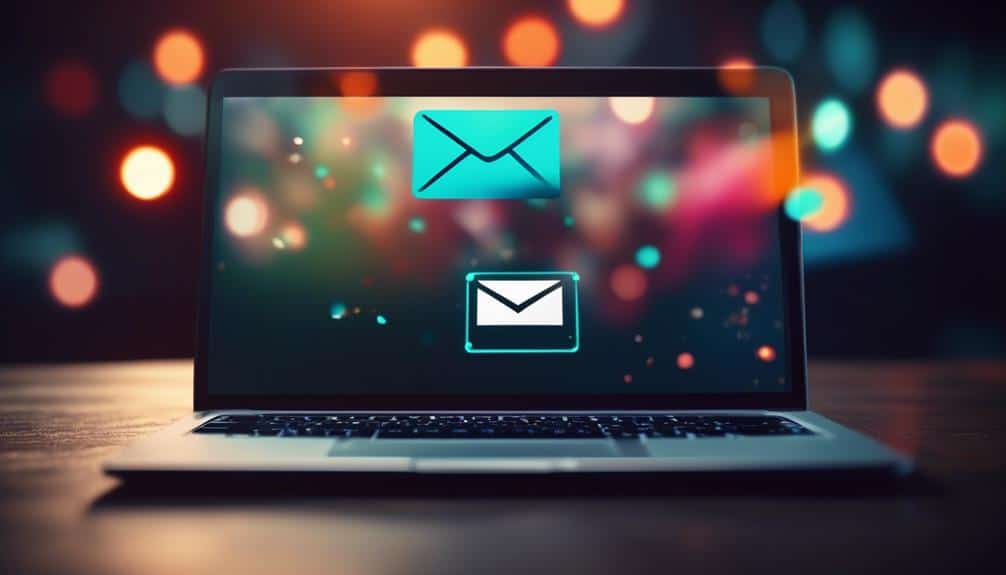Limited Offer: The Ultimate Guide to Crafting Perfect Automated Email Campaigns
Imagine having the power to effortlessly reach your customers, delivering tailored messages directly into their inboxes at the perfect moment.
With our limited offer, you can gain access to the ultimate guide that will transform your email campaigns from ordinary to extraordinary.
The secrets to crafting perfect automated email campaigns are just a click away.
Don't miss out on this opportunity to unlock a world of possibilities and revolutionize your marketing strategy.
Key Takeaways
- Automated email campaigns streamline marketing efforts and allow for personalized content based on interests and behaviors.
- Understanding and targeting your audience through effective segmentation strategies maximizes the effectiveness of automated email campaigns.
- Setting goals and objectives, along with measuring key performance indicators, provides direction and focus for email campaigns.
- Crafting compelling email content with attention-grabbing subject lines, a sense of urgency, and engaging questions can increase open and click-through rates.
The Importance of Automated Email Campaigns

Automated email campaigns are a crucial tool for businesses looking to maximize their marketing efforts and effectively engage with their target audience. In today's fast-paced digital world, understanding automation tools and harnessing the benefits of email marketing can make a significant difference in the success of your business.
One of the primary benefits of using automated email campaigns is the ability to streamline your marketing efforts. With automation tools, you can set up personalized email sequences that automatically send relevant content to your subscribers based on their interests and behaviors. This targeted approach ensures that your audience receives the right messages at the right time, increasing the likelihood of engagement and conversions.
Additionally, automated email campaigns allow you to nurture your leads and build strong relationships with your customers. By sending timely and valuable content, you can establish trust and credibility, positioning your business as a reliable source of information. This not only helps in gaining repeat customers but also encourages word-of-mouth referrals.
Furthermore, automated email campaigns provide valuable insights into the effectiveness of your marketing strategies. With the ability to track open rates, click-through rates, and conversions, you can measure the success of your campaigns and make data-driven decisions to optimize your future efforts.
Understanding Your Target Audience
To effectively engage your target audience with your automated email campaigns, it's essential to have a deep understanding of their needs, preferences, and behaviors. By employing effective targeting strategies and audience segmentation, you can tailor your emails to resonate with your audience and drive meaningful engagement.
Targeting strategies involve identifying specific segments within your target audience and tailoring your messaging to address their unique needs and interests. This can be done by analyzing demographics, psychographics, and purchasing behaviors. By understanding who your audience is and what motivates them, you can craft personalized emails that speak directly to their desires and pain points.
Audience segmentation goes hand in hand with targeting strategies. It involves dividing your audience into distinct groups based on shared characteristics or behaviors. This allows you to deliver more relevant content and offers to each segment, increasing the likelihood of conversions and customer satisfaction.
When implementing audience segmentation, consider factors such as age, gender, location, past purchase history, and engagement with previous emails. By segmenting your audience and crafting emails that speak directly to their interests and needs, you can maximize the effectiveness of your automated email campaigns.
Setting Clear Goals and Objectives

When setting clear goals and objectives for your automated email campaigns, it's crucial to define what you want to achieve and how you'll measure success. Measuring campaign effectiveness is essential to ensuring that your efforts are yielding the desired results. By setting up email automation, you can streamline your processes and reach your target audience more effectively.
To begin, clearly define the objectives you want to accomplish through your automated email campaigns. Are you looking to increase customer engagement, drive sales, or build brand loyalty? Once you have identified your goals, establish key performance indicators (KPIs) that will help you measure the success of your campaigns. These could include open rates, click-through rates, conversion rates, or even customer feedback.
Setting clear goals and objectives not only provides direction for your email campaigns, but it also helps you stay focused on what matters most. It allows you to tailor your content and messaging to align with your objectives, ensuring that every email you send serves a purpose.
Regularly reviewing and analyzing your campaign data will enable you to make informed decisions and optimize your strategies for better results.
Crafting Compelling Email Subject Lines
Now that you have established clear goals and objectives for your automated email campaigns, it's time to captivate your audience with compelling email subject lines that grab their attention.
The subject line is the first thing your recipients see, and it can make or break whether they open your email. To improve your email open rates and increase the chances of your audience clicking through, here are five strategies you can use:
- Keep it short and concise: Aim for subject lines that are no longer than 50 characters. People have limited attention spans, so make every word count.
- Personalize your subject lines: Use your recipient's name or include relevant details to make your emails feel more tailored to them.
- Create a sense of urgency: Use words like 'limited time offer' or 'ending soon' to encourage your audience to take action immediately.
- Ask a compelling question: Pique your recipient's curiosity by asking a question that sparks their interest and makes them want to find out more.
- Use power words: Words like 'exclusive,' 'free,' and 'new' can create excitement and entice your audience to open your email.
Designing Engaging and Mobile-Friendly Templates

Are you ready to captivate your audience with engaging and mobile-friendly email templates that will boost your click-through rates? When it comes to email marketing, mobile optimization and effective email design are crucial. With more and more people accessing their emails on mobile devices, it's essential to create templates that are visually appealing and easy to navigate on smaller screens. Here are some email design tips to help you create captivating templates that will leave a lasting impression on your subscribers.
| Design Tip | Description |
|---|---|
| Keep it Simple | Opt for a clean and minimalist design that focuses on your message. Avoid clutter and excessive visuals that can distract your audience. |
| Use Responsive Design | Ensure your templates are responsive, meaning they adapt to different screen sizes. This will guarantee a seamless viewing experience across devices. |
| Use Clear and Concise Copy | Craft compelling copy that is brief but impactful. Use headings, subheadings, and bullet points to break up the text and make it easier to read on mobile devices. |
| Incorporate Eye-catching Images | Use high-quality images that are visually appealing and relevant to your content. Make sure they are optimized for mobile viewing to avoid slow loading times. |
| Add a Clear Call to Action (CTA) | Place a prominent and easily clickable CTA button in your template. Use contrasting colors to make it stand out and entice your subscribers to take action. |
Personalization and Segmentation Techniques
To create highly effective email campaigns, implementing personalization and segmentation techniques is essential. By tailoring your emails to each individual recipient and dividing your audience into specific segments, you can greatly increase engagement and conversion rates.
Here are five personalization and segmentation strategies that will take your email campaigns to the next level:
- Dynamic content: Use data about your subscribers to personalize the content of your emails. This could include their name, location, past purchases, or browsing history.
- Behavioral segmentation: Segment your audience based on their actions and interactions with your brand. This could include segmenting by purchase history, website browsing behavior, or engagement with previous email campaigns.
- Lifecycle stage segmentation: Divide your subscribers into different stages of the customer journey, such as leads, prospects, or loyal customers. Tailor your emails to their specific needs and interests in each stage.
- Preference-based segmentation: Allow subscribers to indicate their preferences when they sign up, such as the type of content they're interested in or how frequently they want to receive emails. Use this information to send them more relevant and targeted emails.
- Re-engagement campaigns: Identify inactive subscribers and send them targeted emails to re-engage their interest. Offer incentives, exclusive content, or personalized recommendations to encourage them to take action.
Implementing Effective Call-to-Actions

Implementing effective call-to-actions is crucial to compel your subscribers to take the desired action and achieve your campaign goals. A call-to-action (CTA) is a prompt that directs your audience to perform a specific action, such as making a purchase, signing up for a newsletter, or downloading a resource. The placement and wording of your CTAs play a significant role in their effectiveness.
To ensure your CTAs have maximum impact, consider the following tips:
| Call to Action Placement | Effective Wording in Call to Actions |
|---|---|
| Place CTAs above the fold on your email or landing page, where they are immediately visible to your subscribers. | Use action-oriented and persuasive language that clearly states the benefit of taking the desired action. For example, instead of saying "Click here," you can say "Get your free e-book now!" |
| Incorporate CTAs multiple times throughout your email or landing page to reinforce the desired action. Avoid overwhelming your audience with too many CTAs, as that can lead to decision paralysis. | Create a sense of urgency by using phrases like "Limited time offer" or "Only 10 spots left." This prompts your subscribers to take immediate action. |
| Make your CTAs visually appealing by using contrasting colors, bold fonts, or buttons. This helps them stand out and grabs your subscribers' attention. | Keep your CTAs concise and straightforward. Use clear and specific words that convey exactly what you want your audience to do. |
Testing and Optimizing Your Campaigns
Are your email campaigns delivering the results you want? If not, it's time to start testing and optimizing.
A/B testing strategies allow you to experiment with different elements of your emails to see what resonates with your audience. By tracking email performance metrics and focusing on conversion rate optimization, you can make data-driven decisions that will maximize the success of your campaigns.
A/B Testing Strategies
Maximize the effectiveness of your email campaigns by implementing A/B testing strategies to optimize your message. A/B testing allows you to experiment with different variations of your email content to determine what resonates best with your audience. By testing different elements of your emails, such as subject lines, call-to-action buttons, or even the layout, you can gather valuable data and insights to improve your overall campaign performance.
Here are five A/B testing strategies to consider:
- Test different subject lines to see which ones generate higher open rates.
- Experiment with different call-to-action buttons to determine which ones drive more click-throughs.
- Try out different email layouts and designs to see which ones result in higher engagement.
- Vary your email content to gauge what type of content your audience finds most compelling.
- Test different sending times to find the optimal time for maximum response.
Conversion Rate Optimization
To optimize the effectiveness of your email campaigns, it's crucial to test and optimize your campaigns for conversion rate optimization.
Conversion rate analysis is the key to understanding how well your emails are performing and what can be done to improve them. By analyzing metrics such as open rates, click-through rates, and conversion rates, you can identify areas for improvement and make data-driven decisions to optimize your campaigns.
Incorporating email automation best practices, such as personalization, segmentation, and timing, can greatly enhance your conversion rates. Experiment with different subject lines, call-to-action buttons, and content formats to see what resonates best with your audience.
Regularly testing and optimizing your campaigns will help you achieve higher conversion rates, ultimately leading to increased customer engagement and revenue.
Email Performance Metrics
Now that you understand the importance of conversion rate optimization, let's dive into the realm of email performance metrics to further enhance the effectiveness of your campaigns.
Tracking the effectiveness of your email campaigns is crucial to ensure you're reaching your goals and serving your audience effectively. Here are some key email analytics to consider:
- Open Rate: This metric tells you how many recipients actually opened your email. A high open rate indicates a compelling subject line and engaging content.
- Click-through Rate (CTR): CTR measures the percentage of recipients who clicked on a link within your email. A higher CTR means your email content is resonating with your audience.
- Conversion Rate: This metric tracks the number of recipients who took the desired action, such as making a purchase or signing up for a webinar. A higher conversion rate indicates an effective call-to-action.
- Bounce Rate: Bounce rate shows the percentage of emails that weren't delivered to recipients' inboxes. A high bounce rate may indicate issues with your email list or email deliverability.
- Unsubscribe Rate: This metric measures the number of recipients who opted out of receiving further emails from you. A low unsubscribe rate signifies that your emails are relevant and valuable to your audience.
Analyzing Metrics and Tracking Success
Are your automated email campaigns delivering the results you want? To find out, you need to analyze the metrics and track your success.
Performance measurement techniques and key success indicators are essential tools for evaluating the effectiveness of your campaigns. By understanding these metrics, you can make data-driven decisions to optimize your email marketing strategy and achieve better results.
Performance Measurement Techniques
By utilizing effective performance measurement techniques, you can gain valuable insights into the success of your automated email campaigns. Performance analysis and data interpretation are crucial for understanding how well your campaigns are performing and identifying areas for improvement.
Here are five techniques to help you measure and track the performance of your automated email campaigns:
- Conversion Rate Tracking: Monitor the percentage of recipients who take the desired action, such as making a purchase or signing up for a newsletter.
- Open and Click-Through Rates: Measure how many recipients open your emails and click on the links inside them.
- A/B Testing: Test different variations of your emails to see which ones generate better results.
- Return on Investment (ROI) Analysis: Calculate the revenue generated from your email campaigns and compare it to the costs involved.
- Subscriber Growth Rate: Track the rate at which your email list is growing to gauge the effectiveness of your lead generation efforts.
Key Success Indicators
To truly gauge the success of your automated email campaigns, it is essential to analyze key success indicators and track metrics that provide valuable insights into your campaign performance. By measuring these indicators, you can identify areas of improvement and make data-driven decisions to optimize your campaigns. Here are some key success indicators that you should consider tracking:
| Key Success Indicators | Description |
|---|---|
| Open Rate | The percentage of recipients who open your emails. |
| Click-through Rate (CTR) | The percentage of recipients who click on links within your emails. |
| Conversion Rate | The percentage of recipients who take the desired action, such as making a purchase or signing up for a webinar. |
| Bounce Rate | The percentage of emails that are undeliverable. |
| Unsubscribe Rate | The percentage of recipients who unsubscribe from your emails. |
To track these metrics, you can utilize measurement tools provided by email automation platforms. These tools allow you to monitor your campaign's performance in real-time, helping you make informed decisions to improve your email marketing strategy. Remember, analyzing key success indicators is crucial for optimizing your automated email campaigns and achieving your desired goals.
Frequently Asked Questions
How Can I Ensure That My Automated Email Campaigns Are Reaching the Right Audience?
To ensure your automated email campaigns reach the right audience, employ targeting strategies and carefully select your audience. This will maximize the effectiveness of your campaigns and ensure you're serving the right people.
What Are Some Best Practices for Designing Visually Appealing and Mobile-Friendly Email Templates?
To design visually appealing and mobile-friendly email templates, consider the importance of responsive design in email marketing. Make sure your templates look great on any device and prioritize user experience.
How Can I Effectively Personalize and Segment My Email Campaigns to Increase Engagement?
To effectively personalize and segment your email campaigns, you need to understand the benefits of personalization and use segmentation techniques. By tailoring content and targeting specific groups, you can increase engagement and provide valuable experiences for your subscribers.
What Are Some Effective Strategies for Implementing Call-To-Actions in Automated Email Campaigns?
To maximize click-through rates in your automated email campaigns, implement effective call-to-action strategies. Try A/B testing different approaches to optimize conversions. Get the guide now for more tips on crafting perfect campaigns. Limited offer!
How Can I Track the Success of My Automated Email Campaigns and Optimize Them for Better Results?
To track the success of your automated email campaigns and optimize for better results, start by tracking metrics like open rates and click-through rates. Then, use A/B testing to experiment with different strategies and find what works best for your audience.
Conclusion
In conclusion, crafting the perfect automated email campaigns is crucial for businesses looking to engage and convert their target audience.
By understanding your audience, setting clear goals, and using personalization techniques, you can create compelling email subject lines and engaging templates that are mobile-friendly.
Implementing effective call-to-actions and continuously testing and optimizing your campaigns will ultimately lead to success.
Make use of metrics and tracking to analyze the effectiveness of your campaigns and make necessary improvements.
Don't miss out on this limited offer to master the art of automated email campaigns!








